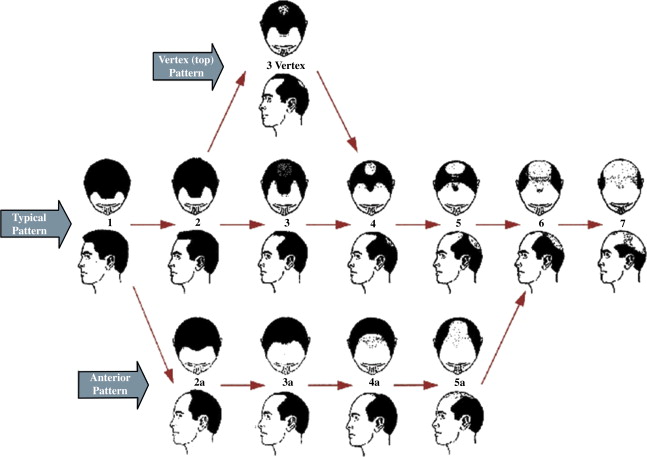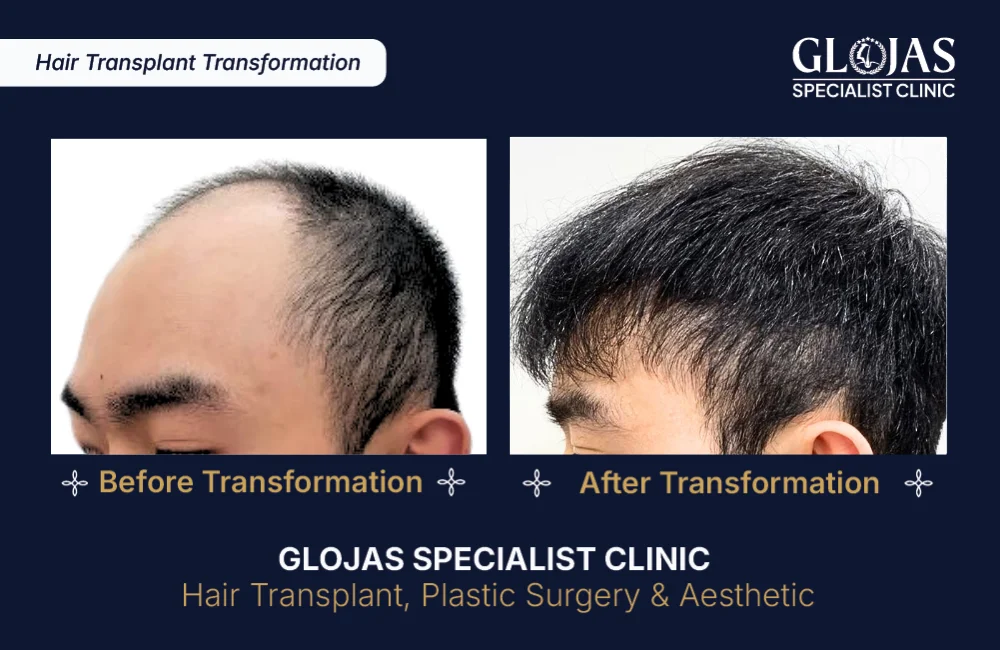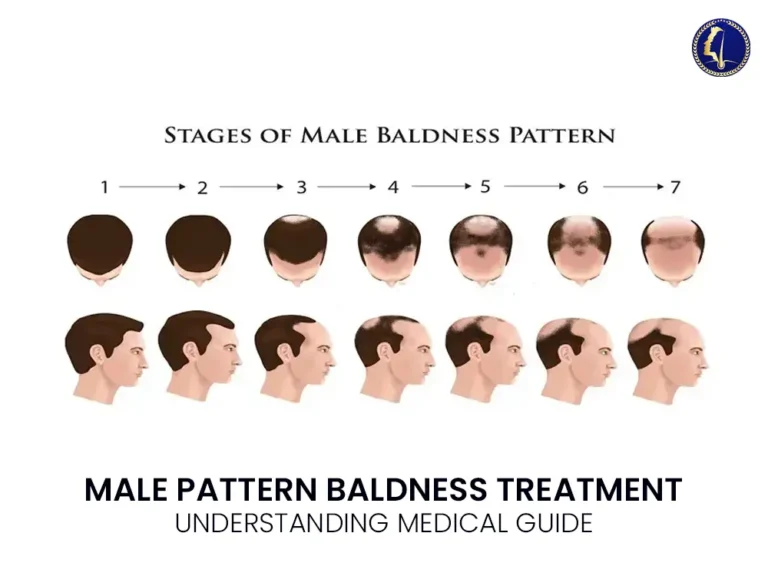Male pattern baldness, or androgenetic alopecia, is the most common hair loss in men, driven by genetics and the hormone DHT. Hair thins on the crown and temples in predictable patterns. Early treatment—including medications, procedures, and lifestyle adjustments—can slow hair loss, promote regrowth, and improve both appearance and confidence.
What Is Male Pattern Baldness?

Male pattern baldness (MPB) is a hereditary condition that causes progressive hair thinning. It usually starts with a receding hairline or thinning at the crown, forming an “M” shape. MPB is caused by genetics and hormones, especially dihydrotestosterone (DHT), which shrinks hair follicles over time.
How Common Is Male Pattern Baldness?
-
About 50% of men experience some hair loss by age 50.
-
Starts as early as late teens or early 20s in some men.
-
Prevalence varies by ethnicity: more common in Caucasians, slightly less in Asian and African populations.
Causes & Biology of Male Pattern Baldness
1. Genetics
Your family history largely determines risk. Men with relatives who have MPB are more likely to develop it.
2. Hormonal Influence
-
DHT, derived from testosterone, binds to hair follicles, shrinking them.
-
Miniaturized follicles produce thinner, shorter hairs, eventually stopping growth.
3. Hair Follicle Cycle Changes
-
Normal hair cycles: anagen (growth), catagen (transition), telogen (rest)
-
In MPB, anagen shortens, telogen lengthens, and follicles miniaturize.
Symptoms & Staging of Male Pattern Baldness
Common Signs
-
Thinning hair at temples and crown
-
Receding hairline forming an “M”
-
Noticeable shedding while washing or brushing
-
Decreased hair density overall
Hamilton-Norwood Scale
-
Clinically used to classify male pattern baldness stages
-
Stage I: Minimal hairline recession
-
Stage VII: Advanced hair loss with only a thin band remaining
Diagnosis
-
Physical Exam: Dermatologists assess pattern and density
-
Pull Test: Checks shedding severity
-
Scalp Biopsy (rare): Confirms follicle miniaturization if diagnosis is unclear
-
Differential Diagnosis: Telogen effluvium, alopecia areata, scarring alopecia
Tip: Early evaluation allows better treatment outcomes.
Male Pattern Baldness Treatment Options In Malaysia
1. Medications
-
Minoxidil (topical): Stimulates follicles, slows shedding
-
Finasteride (oral): DHT inhibitor, effective in 70–80% of men
-
Dutasteride (oral): Stronger DHT blocker; prescription required
Note: Continuous use is crucial. Stopping often reverses gains.
2. Low-Level Laser Therapy (LLLT)
-
Stimulates hair follicles
-
Devices: combs, caps, or helmets
-
Best for early thinning
3. Hair Transplant Surgery
-
FUE (Follicular Unit Extraction): Individual follicles transplanted
-
FUT (Follicular Unit Transplant): Strip of scalp harvested and implanted
-
Suitable for stable, advanced hair loss
Study found that FUE hair transplants noticeably increased hair density and coverage in men with male pattern baldness, helping most patients achieve satisfying results and improving their overall quality of life.
Study link: https://pubmed.ncbi.nlm.nih.gov/33162652/
4. Emerging Therapies
-
Topical anti-androgens
-
Growth factor-based treatments
Evidence-based approach: Combine conventional with adjunctive therapies under dermatologist guidance.
5. Lifestyle & Hair Care
-
Balanced diet: protein, iron, zinc
-
Gentle hair care: avoid harsh chemicals, tight hairstyles
-
Manage stress and maintain sleep quality
Side Effects & Safety
-
Minoxidil: Scalp irritation, unwanted facial hair
-
Finasteride/Dutasteride: Sexual side effects in a small percentage
-
Surgical: Infection risk, temporary shock loss
Always consult a dermatologist for personalized guidance.
Psychosocial Impact
Male Pattern Baldness can affect:
-
Confidence and self-image
-
Social and professional life
-
Mental health (anxiety, depression)
Support: Counseling or support groups may help alongside medical treatments.
Prevention & Maintenance of Male Pattern Baldness
-
Start treatment at first thinning signs
-
Sun protection for scalp
-
Avoid smoking; linked to accelerated hair loss
-
Regular check-ups to monitor progression
FAQs about Male Pattern Baldness
Q: Is male pattern baldness reversible?
A: Not fully. Treatments can slow or partially reverse hair loss, especially if started early.
Q: How long before results appear?
A: Minoxidil: 3–6 months. Finasteride: 6–12 months. Patience is key.
Q: Can diet or lifestyle stop hair loss?
A: Healthy habits support hair but cannot reverse genetic baldness.
Q: Are hair transplants permanent?
A: Transplanted hair usually lasts, but non-transplanted hair may continue thinning.
Q: Can women get male pattern baldness?
A: Women can have androgenetic hair loss, usually diffuse thinning over the scalp.
Q: What’s the Norwood scale?
A: A clinical chart that classifies stages of male hair loss from mild to severe.
Key Takeaways
-
MPB is hereditary and hormone-driven
-
Early recognition and treatment improve outcomes
-
Medications, laser therapy, and surgery are mainstay options
-
Lifestyle supports hair health but doesn’t replace therapy
-
Addressing emotional impact is part of holistic care
Regain Your Confidence Back With Experts

At GLOJAS Specialist Clinic in Malaysia, our experienced specialist, Prof. Dato’ Dr. JasG provide evidence-based male pattern baldness treatment, combining FDA-approved medications, advanced hair restoration procedures, and personalized care plans. We prioritize clinically proven therapies, patient safety, and long-term results, ensuring every client receives trustworthy, expert guidance to manage hair loss effectively.
